Studies show that sunrooms with strategically placed plants can reduce indoor air pollution by up to 87%. You’ll discover how to transform your sunroom into a year-round oasis through carefully curated plant arrangements that maximize both aesthetic appeal and functionality. From cascading pothos creating living walls to desert-inspired succulent displays measuring 12-24 inches in height, these ten arrangements combine design principles with practical plant care. The following collection offers solutions for every sunroom style and skill level.
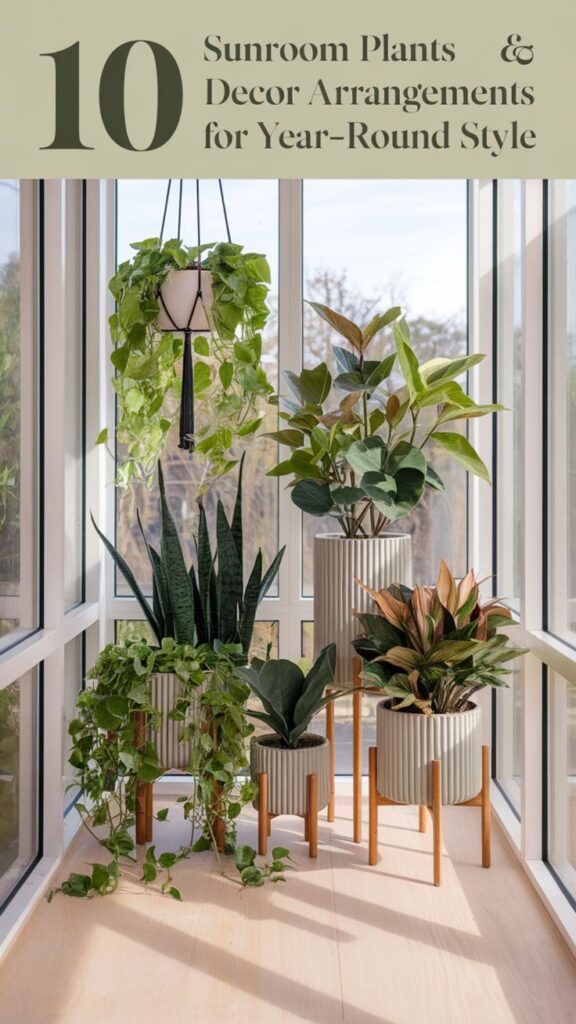
Contents
- 1 The Vertical Garden Paradise: Stacked Shelving With Trailing Plants
- 2 Tropical Corner Statement: Large-Leafed Plants in Mixed Heights
- 3 Minimalist Desert Vibes: Modern Succulent Display
- 4 Window-Side Wonder: Light-Loving Plants in Graduated Sizes
- 5 Bohemian Hanging Garden: Macramé and Air Plants
- 6 The Living Divider: Strategic Plant Placement as Room Separator
- 7 Mediterranean-Inspired Collection: Herbs and Citrus Trees
- 8 Zen Garden Elements: Asian-Inspired Plant Groupings
- 9 The Color Block Effect: Plants Arranged by Foliage Hues
- 10 Natural Reading Nook: Cozy Plant Clusters Around Seating
The Vertical Garden Paradise: Stacked Shelving With Trailing Plants
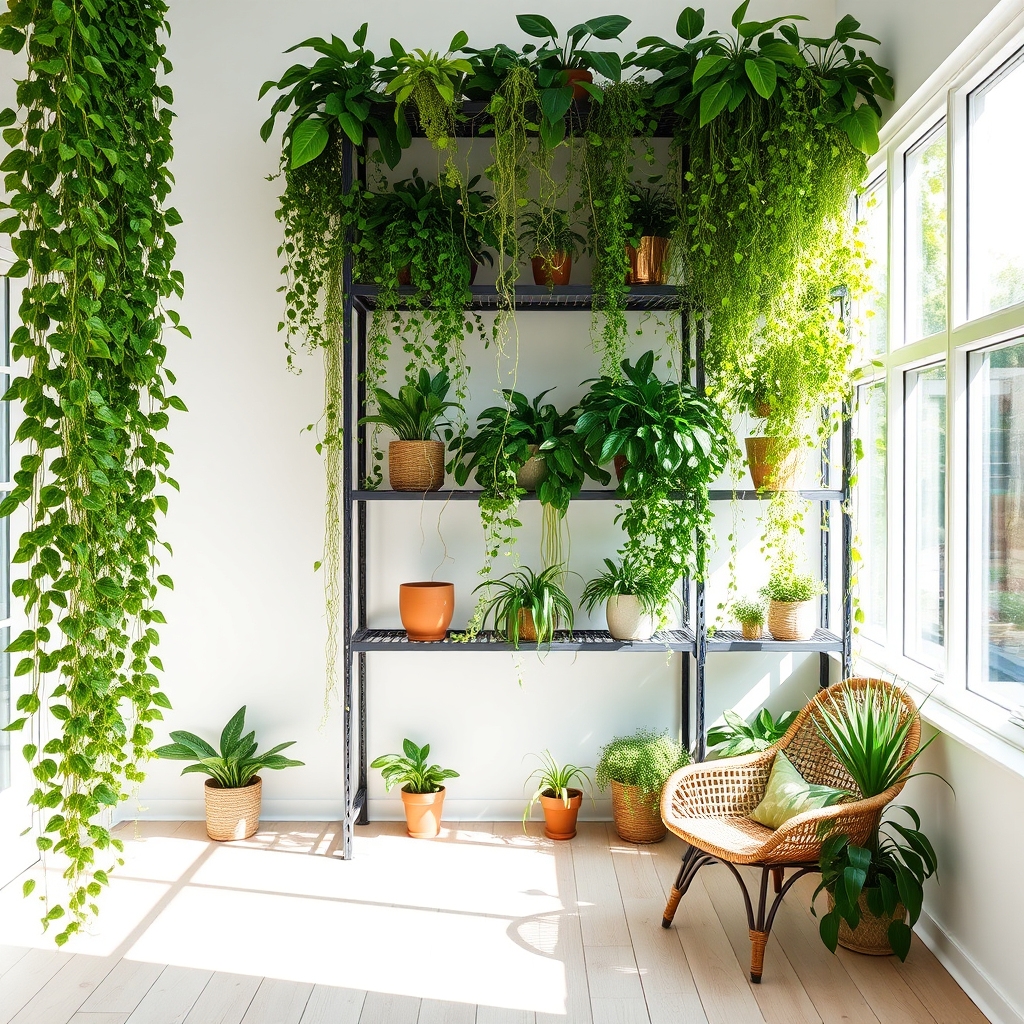
A stacked shelving arrangement in a sunroom creates a dramatic vertical garden display that maximizes space while showcasing cascading foliage.
Multiple tiers of sturdy shelves, typically made of wood or metal, hold an array of trailing plants like pothos, ivy, string of pearls, and spider plants. The plants cascade downward from each level, creating living curtains of greenery that soften the rigid structure of the shelving unit.
This arrangement style draws the eye upward, making use of vertical space while adding depth and dimension to the sunroom. The layered effect allows sunlight to filter through different levels, creating interesting shadow patterns throughout the day.
Strategic placement of plants with varying lengths and textures creates a lush, jungle-like atmosphere that transforms a basic shelving unit into a living wall of foliage.
Tropical Corner Statement: Large-Leafed Plants in Mixed Heights
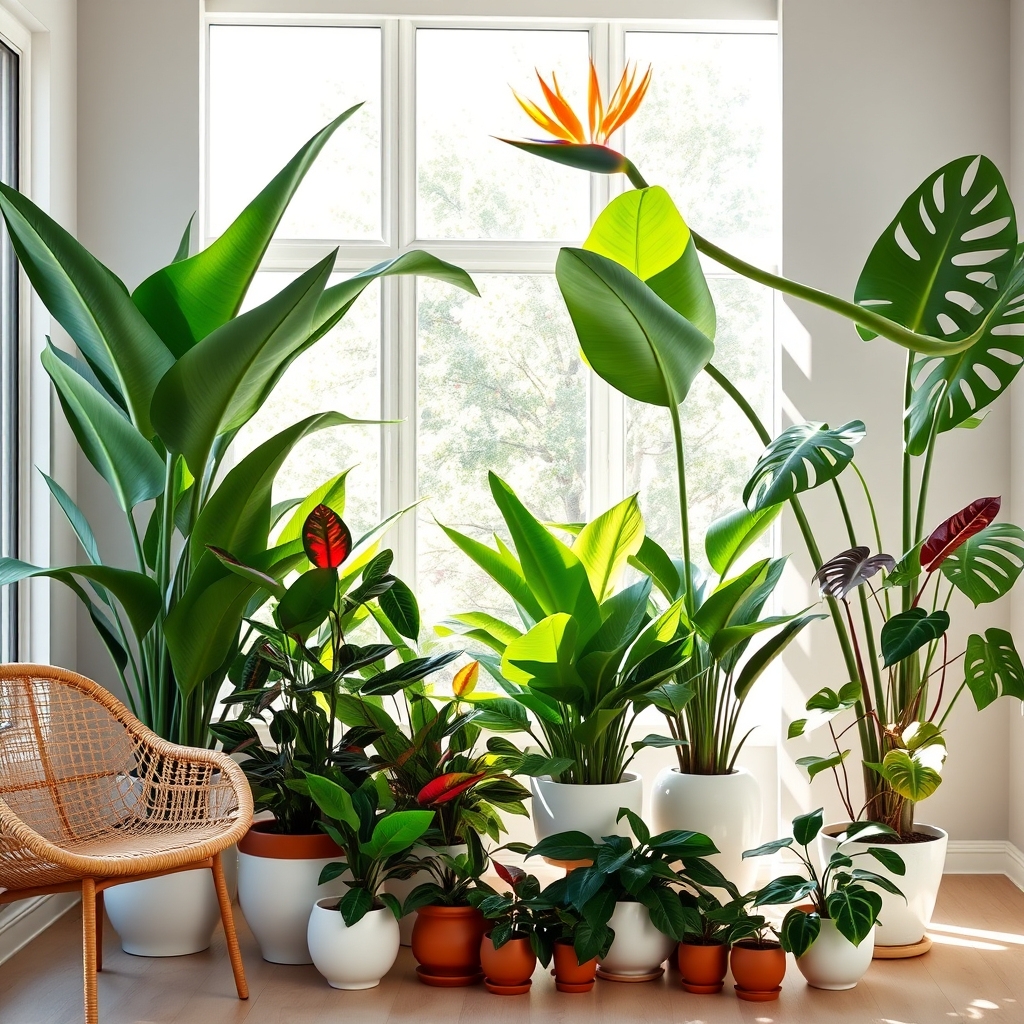
A Tropical Corner Statement featuring large-leafed plants in mixed heights creates a dramatic, jungle-like focal point in the sunroom.
Tall plants like Monstera deliciosa and Bird of Paradise form the backdrop, while medium-height rubber plants and philodendrons occupy the middle ground.
Shorter tropical varieties like calatheas and prayer plants fill the lower level, creating a layered, dimensional display.
The varying heights and oversized foliage create visual interest and depth, while the grouping of different leaf shapes and textures produces a lush, tropical atmosphere.
This arrangement typically occupies a corner space, maximizing natural light exposure and making a bold architectural statement through plant form alone.
Minimalist Desert Vibes: Modern Succulent Display
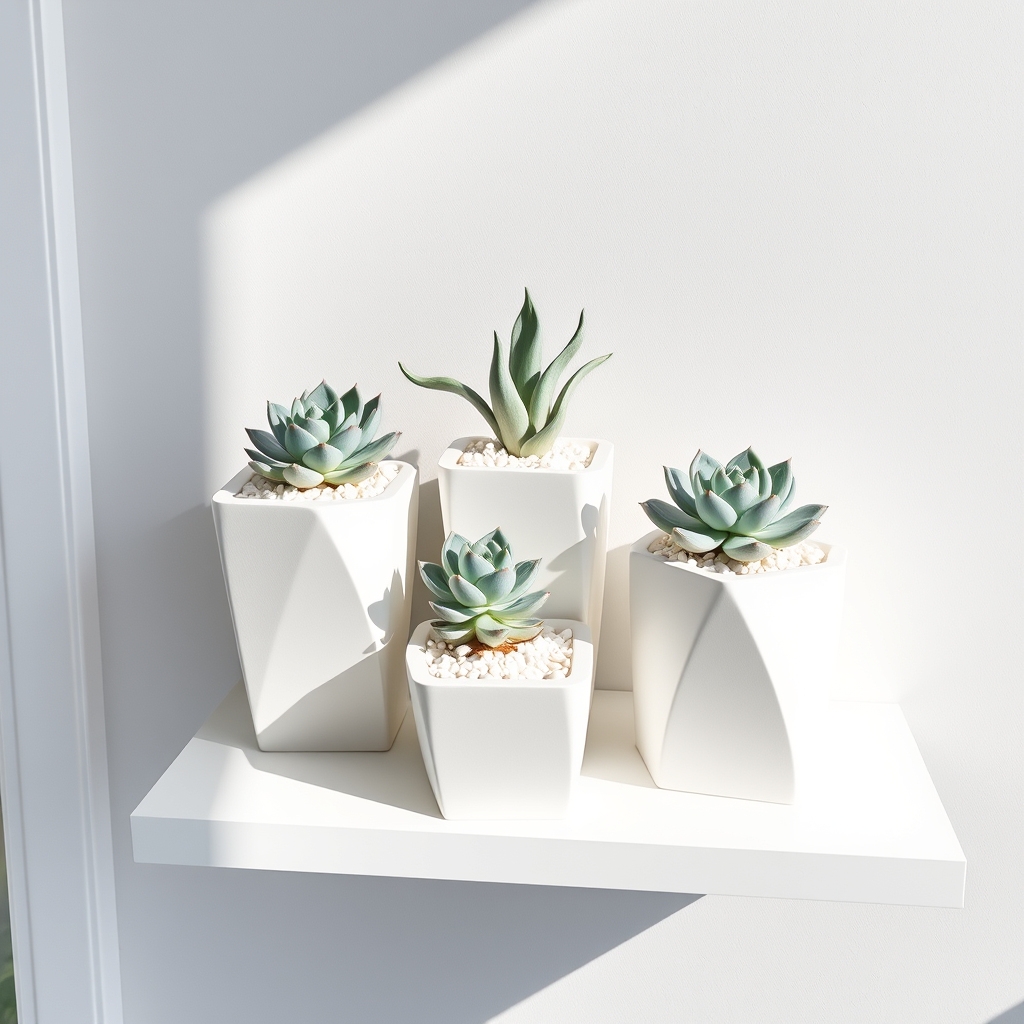
Minimalist Desert Vibes: Modern Succulent Display showcases a clean, contemporary arrangement of carefully selected succulents in geometric containers.
The design features low-profile planters in neutral tones like white, gray, or matte black, arranged at varying heights on sleek platforms or floating shelves.
Small to medium-sized succulents with distinct shapes and subtle color variations create visual interest while maintaining simplicity.
The arrangement often incorporates natural elements like pale sand, small pebbles, or light-colored gravel as top dressing.
Key characteristics include ample negative space between plants, asymmetrical groupings, and a monochromatic or limited color palette that emphasizes the succulents’ architectural forms.
This style perfectly balances desert flora with modern design sensibilities, creating a sophisticated yet organic focal point in any sunroom.
Window-Side Wonder: Light-Loving Plants in Graduated Sizes
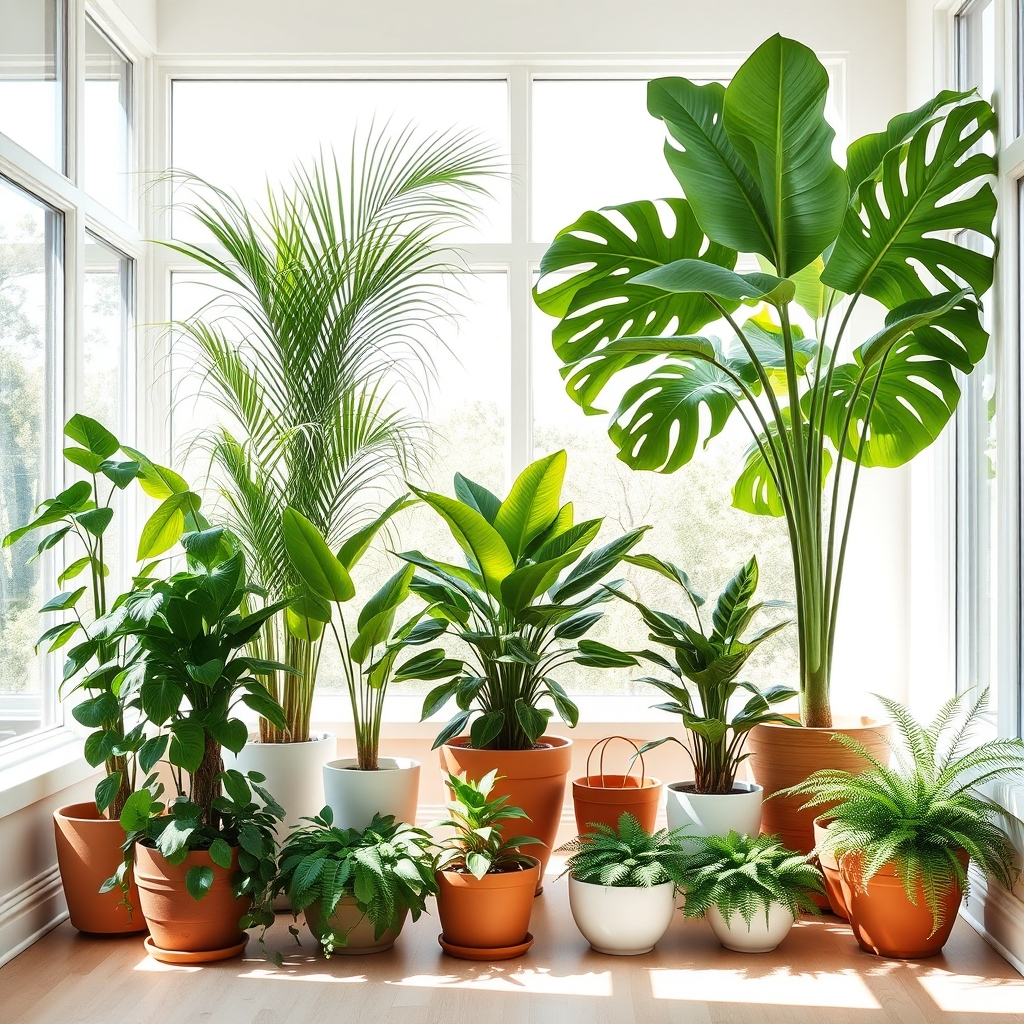
Window-Side Wonder: Light-Loving Plants in Graduated Sizes creates a visually dynamic display by arranging sun-loving plants in descending heights near sunroom windows.
Taller plants like palms and fiddle leaf figs stand at the back, while medium-height plants such as monstera and bird of paradise occupy the middle ground.
Shorter specimens like pothos and ferns fill the front row. This tiered arrangement maximizes light exposure for all plants while forming an aesthetically pleasing cascade effect.
The graduated sizing ensures each plant remains visible and creates depth in the space, similar to a natural forest canopy structure.
Plants are typically grouped in odd numbers with varying leaf textures and shapes to add visual interest.
Bohemian Hanging Garden: Macramé and Air Plants

Bohemian Hanging Garden: Macramé and Air Plants creates a laid-back, artistic vertical display combining handwoven macramé plant holders with low-maintenance air plants.
The design features cream or natural-colored cotton rope macramé hangers in various intricate patterns, suspended at different heights from the ceiling or wall-mounted hooks.
Air plants (Tillandsia) nestle within the woven cradles, requiring no soil and adding sculptural green elements to the arrangement.
The combination offers a free-spirited, textural aesthetic that maximizes vertical space while minimizing floor footprint in the sunroom.
Small crystals, wooden beads, or copper accents often embellish the macramé pieces, enhancing the bohemian vibe.
The Living Divider: Strategic Plant Placement as Room Separator
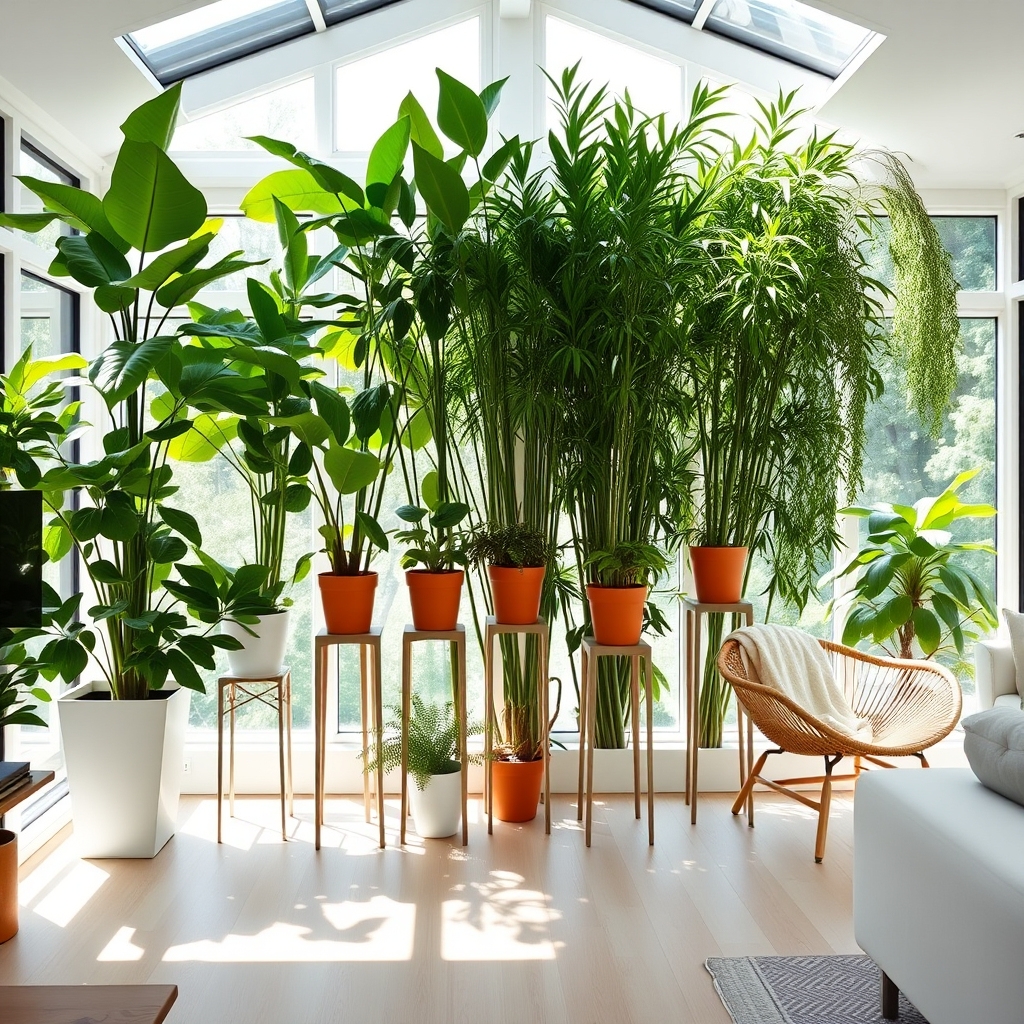
Strategic plant placement as a living divider transforms sunroom spaces by creating natural boundaries without solid walls. Tall plants like bamboo, fiddle leaf figs, or palm varieties are arranged in a linear or staggered formation to establish distinct zones within the room. These green barriers typically stand 5-8 feet tall and can span several feet in width, depending on the space requirements.
The living divider features multiple height levels, with taller specimens in the back and shorter plants in front, creating a layered, jungle-like effect. Plants are often positioned in decorative containers of varying sizes, placed on stands or risers to add dimension. Common arrangements include combining climbing plants on trellises with bushy floor plants and hanging varieties to create a full, natural screen.
This botanical boundary maintains an open, airy feel while defining separate areas for different activities, such as reading nooks or conversation spaces. The arrangement allows filtered light to pass through, casting interesting shadows and maintaining the bright atmosphere essential to a sunroom setting.
Mediterranean-Inspired Collection: Herbs and Citrus Trees
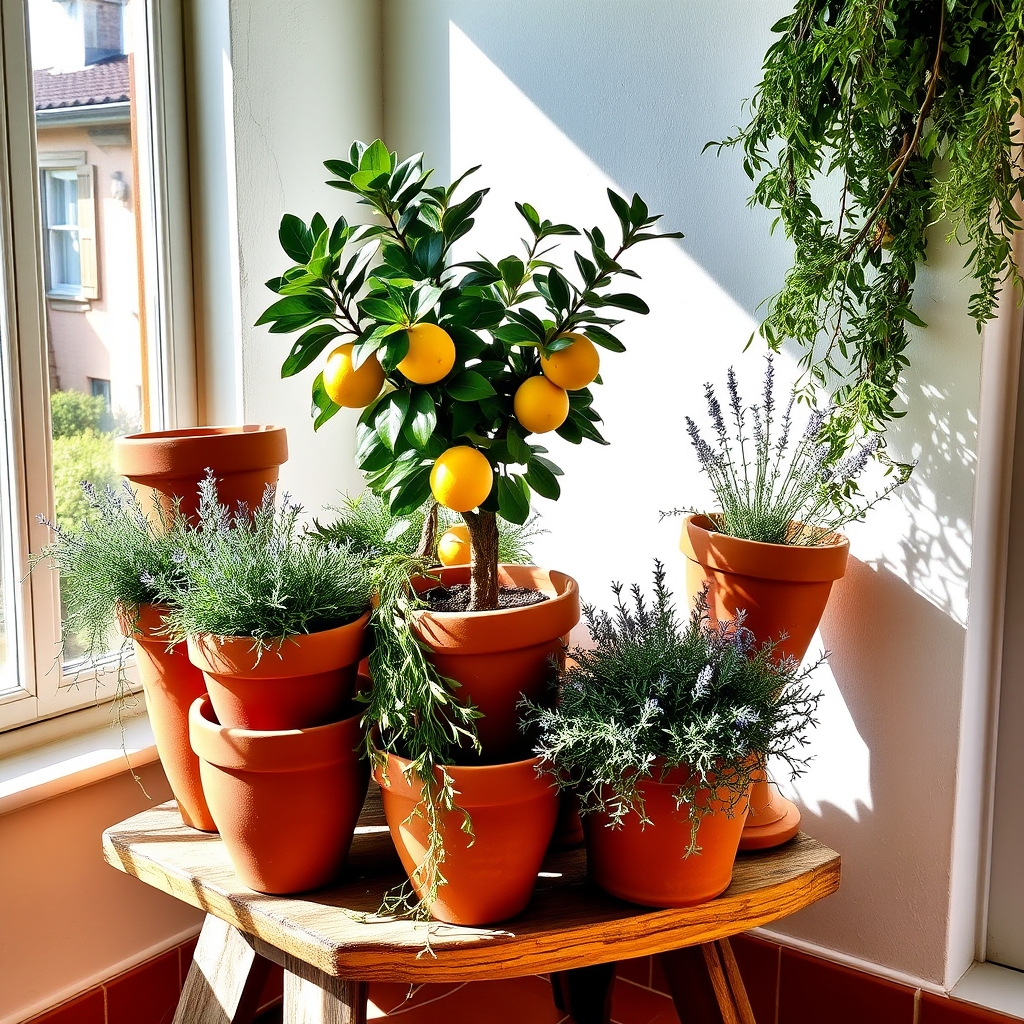
A curated arrangement featuring fragrant herbs like rosemary, thyme, and lavender alongside compact citrus trees creates an elegant Southern European atmosphere.
The collection typically combines terra cotta pots of varying heights, with climbing herbs cascading over pot edges while dwarf lemon, lime, or orange trees serve as focal points.
Fresh herbs provide both ornamental value and culinary purpose, while citrus trees offer glossy evergreen foliage and seasonal fruit.
This arrangement thrives in bright sunlight and brings Mediterranean charm through its layered textures, aromatic properties, and warm earthy container palette.
Key features:
- Drought-tolerant herbs in rustic terra cotta
- Dwarf citrus trees as vertical anchors
- Multi-level display with climbing and trailing plants
- Functional beauty combining ornamental and edible plants
- Strong aromatic presence
- Classic Mediterranean materials and styling
Zen Garden Elements: Asian-Inspired Plant Groupings
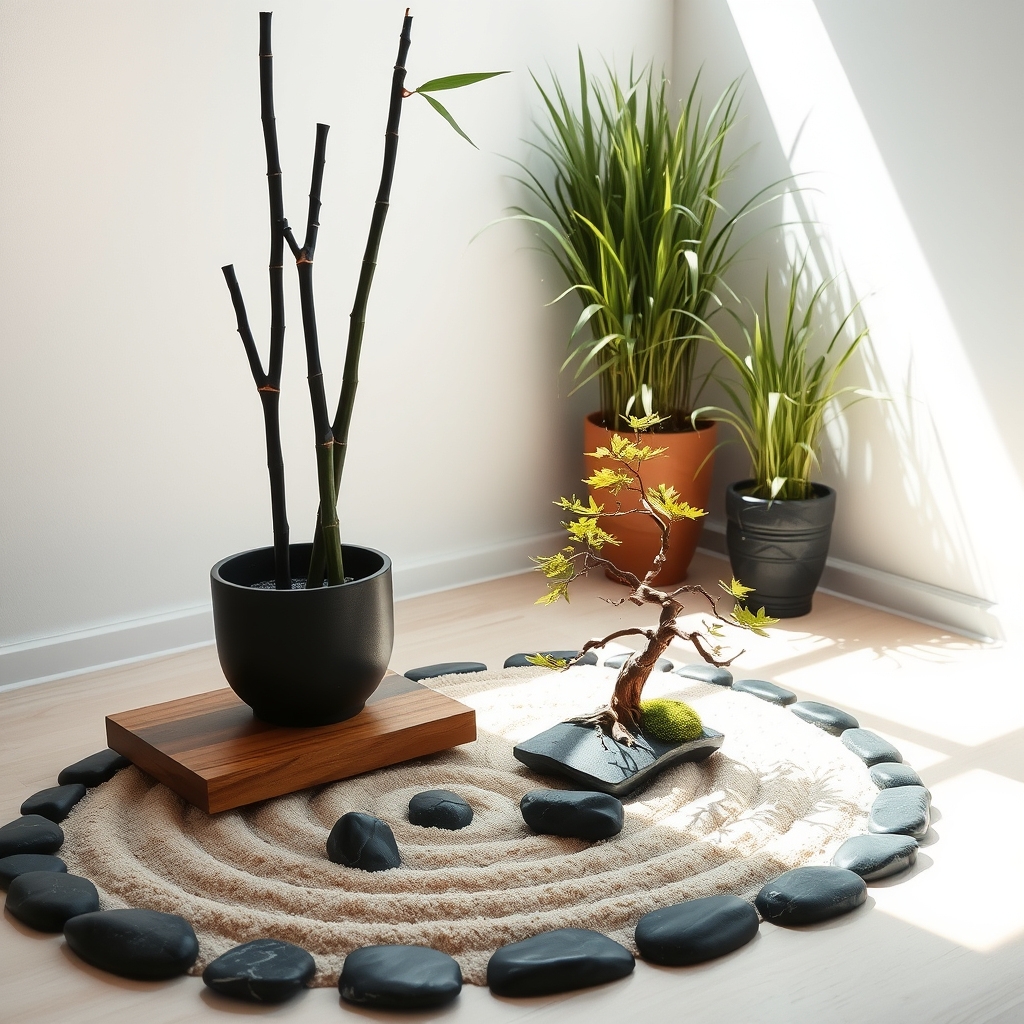
Minimalist arrangements featuring carefully positioned plants that create a sense of balance and tranquility.
Small bamboo stands, bonsai trees, and Japanese forest grass are positioned asymmetrically with ample space between each specimen. Natural elements like smooth river rocks, raked sand patterns, and moss gardens complement the plantings.
Key visual characteristics include:
- Clean, uncluttered groupings with emphasis on negative space
- Low-growing ground covers like pachysandra or mondo grass
- Sculptural plants with interesting forms and textures
- Natural stone accents and water features
- Neutral-colored ceramic or stone containers
- Strategic placement that draws the eye through the space
- Simple color palette focused on various shades of green
- Carefully pruned specimens maintaining intentional shapes
The arrangement creates a meditative atmosphere while incorporating traditional Japanese garden design principles of simplicity, naturalness, and suggestion rather than full disclosure.
The Color Block Effect: Plants Arranged by Foliage Hues
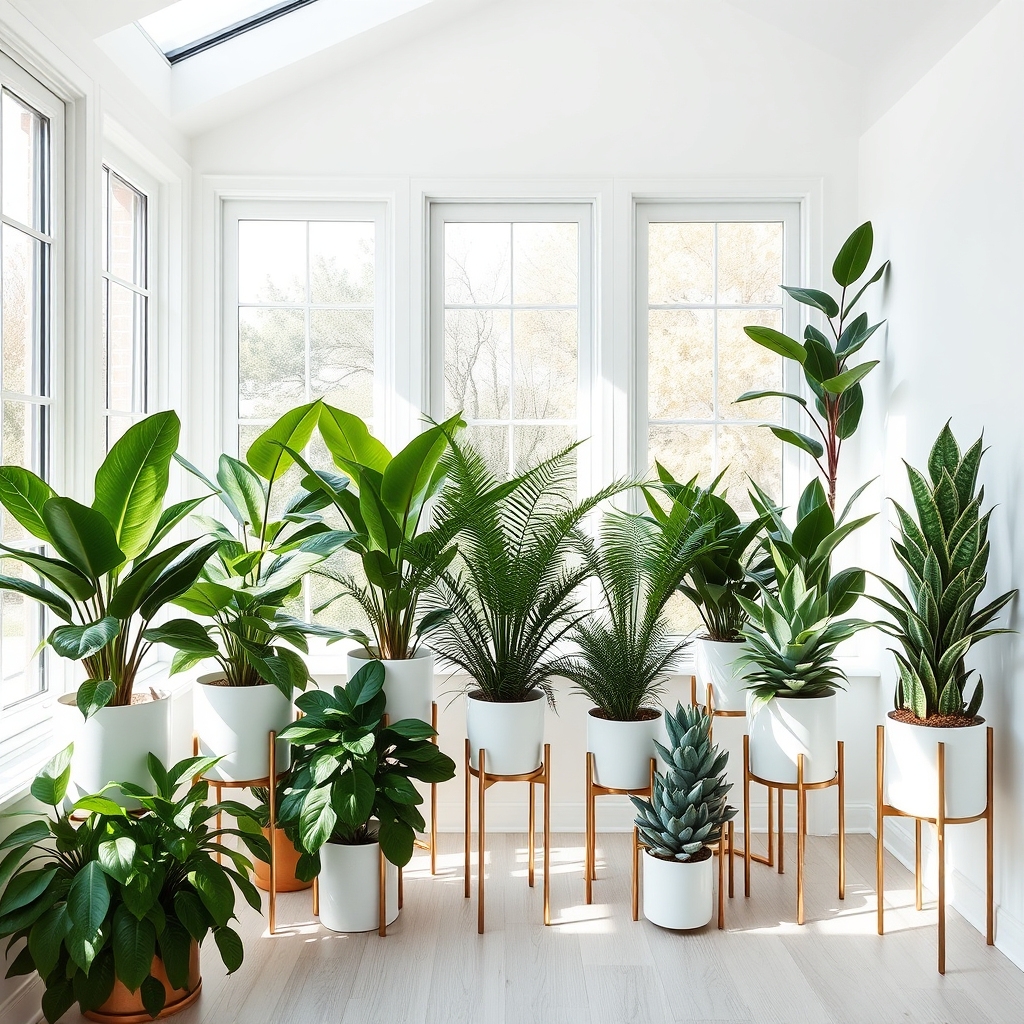
The Color Block Effect with plant arrangements creates distinct visual zones in a sunroom by grouping plants according to their foliage colors.
Plants with similar leaf shades are clustered together, forming blocks of green, silver, purple, or variegated foliage. This design technique transitions smoothly from one color section to another, such as deep forest greens flowing into lighter sage tones, then transitioning to silvery-blue succulents.
This arrangement style makes a bold visual statement while maintaining organization and harmony.
Key features include:
- Graduated height placement within each color block
- Clear boundaries between different colored sections
- Strategic use of contrasting colors for visual impact
- Layered placement from darkest to lightest shades
- Consideration of leaf textures within color groups
The effect creates an organized, gallery-like display that highlights the natural variety of plant colors while maintaining a cohesive, modern aesthetic.
Natural Reading Nook: Cozy Plant Clusters Around Seating
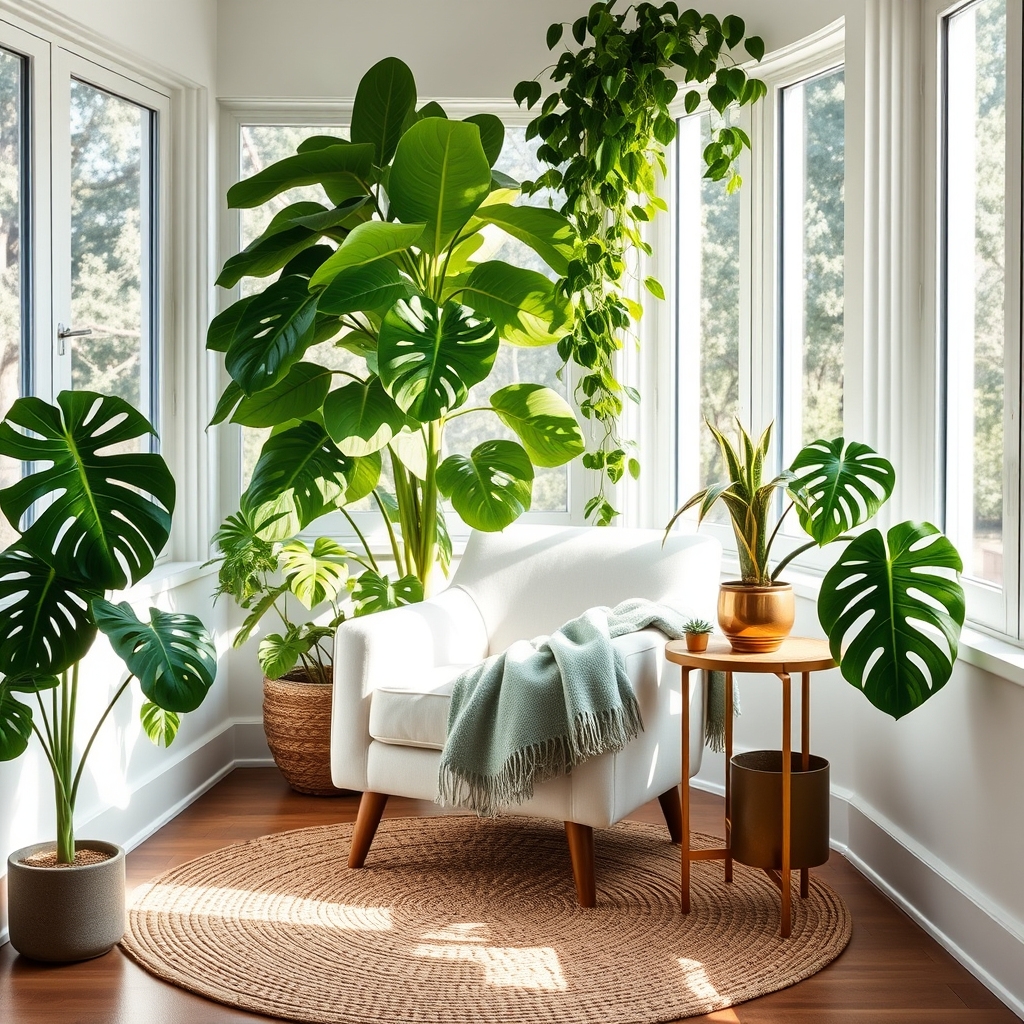
A natural reading nook with cozy plant clusters around seating transforms a sunroom corner into an intimate retreat.
Varying heights of plants surround comfortable seating, with tall specimens like fiddle leaf figs or bird of paradise creating a canopy effect behind chairs or loungers. Medium-sized plants occupy side tables and plant stands, while smaller varieties rest on windowsills or tucked into bookshelf corners.
Trailing plants like pothos or string of pearls cascade from elevated positions, adding vertical interest. The arrangement incorporates plush cushions and throws among the greenery, creating a seamless blend between comfort and nature.
Strategic plant placement ensures adequate natural light reaches both the plants and reading material while maintaining an enclosed, sanctuary-like atmosphere.
